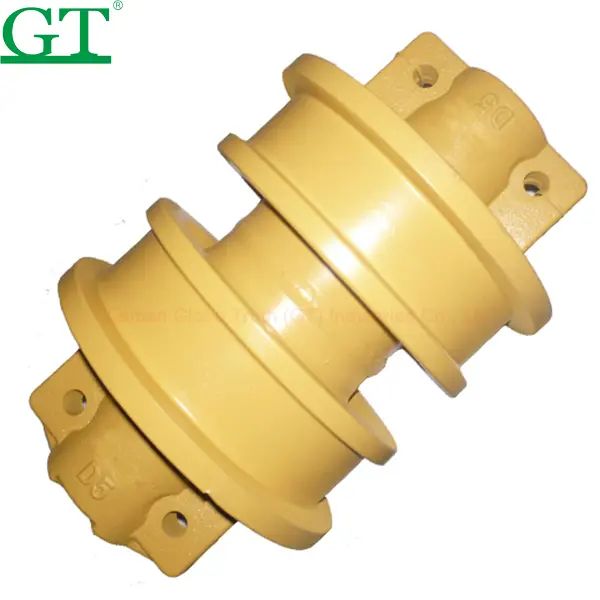Track rollers play a crucial role in the performance of heavy machinery, such as excavators, bulldozers, and other tracked vehicles. These components help facilitate smooth movement and load distribution, ensuring durability and efficiency in harsh working conditions. This article delves into the design and manufacturing processes of track rollers, exploring how to meet specific operational needs, and the latest trends in manufacturing techniques.
Track rollers are primarily designed to support and guide the track chains of heavy machinery. They play a pivotal role in maintaining the tension and alignment of the track, which is essential for optimal machine performance. Typically located under the chassis, track rollers endure continuous friction, pressure, and impact. As a result, they must be designed with high strength and resilience to withstand demanding environments.
When designing track rollers, several factors must be considered to ensure that the component meets specific operational needs. These include:
Load Capacity: Track rollers must be able to handle high static and dynamic loads without failure. The material strength and overall design must be capable of supporting the weight of the machinery and its operational demands.
Durability: Given the rough working conditions and constant friction, track rollers need to be highly durable. The use of wear-resistant materials, such as heat-treated steel, ensures long-lasting performance.
Environmental Resistance: Track rollers are often exposed to moisture, dirt, and extreme temperatures. Designers must choose materials and finishes that are resistant to corrosion and wear, such as galvanized coatings or advanced rubber seals.
Efficiency and Performance: Track rollers should be designed to minimize rolling resistance, which can improve fuel efficiency and overall machine performance. This requires precision engineering to ensure smooth operation.
Maintenance and Serviceability: Track rollers should be easy to maintain. Features like grease fittings for lubrication and replaceable bearings can significantly extend the lifespan of the rollers and reduce downtime.
The selection of materials for track rollers is critical for ensuring that they meet the necessary performance standards. Common materials include:
High-Carbon Steel: Known for its excellent strength and wear resistance, high-carbon steel is frequently used in track roller design. It provides a good balance between cost and performance.
Alloy Steel: Alloy steels, particularly those with chromium or molybdenum, are used for their superior strength and resistance to wear and fatigue.
Ductile Iron: Ductile iron track rollers offer enhanced toughness and resistance to cracking under stress. It’s a popular choice in manufacturing durable rollers for construction equipment.
Rubber and Polyurethane Seals: These materials are often used in conjunction with the metal components to create effective sealing systems that prevent debris and water from entering the roller’s internal components.

With advancements in manufacturing technology, several techniques are commonly used in the production of track rollers. These include:
Casting: Casting remains one of the most common methods for producing track rollers. The process involves pouring molten metal into a mold, where it cools and solidifies into the desired shape. Casting is ideal for creating complex shapes and ensuring uniformity in production.
Forging: For applications requiring higher strength and durability, forging is used to shape the metal under high pressure. This process aligns the grain structure of the material, resulting in superior mechanical properties, especially in terms of tensile strength.
Machining: After casting or forging, track rollers often undergo machining processes, such as turning, milling, and grinding. These processes are used to achieve precise dimensions and ensure smooth surfaces for optimal performance.
Heat Treatment: Heat treatment processes like quenching and tempering are employed to enhance the hardness and strength of track rollers. This process is crucial for increasing the wear resistance of the component.
Surface Coating: To improve the corrosion resistance of track rollers, they are often coated with materials such as galvanization or specialized anti-corrosion coatings. This is particularly important for equipment used in harsh environmental conditions.
When looking for track roller suppliers, it's essential to consider factors such as quality, experience, and technological capabilities. A reliable supplier should offer:
Custom Solutions: Many applications require custom-designed track rollers. The best suppliers can provide tailored solutions based on the specific needs of the machinery and working environment.
Quality Assurance: Look for suppliers who offer strict quality control procedures. This includes material testing, dimensional checks, and durability testing to ensure the rollers meet the required standards.
Cost-Effectiveness: While quality is paramount, it's also important to find a supplier who offers competitive pricing without compromising on the integrity of the product.
Reputation and Experience: Established track roller suppliers with a strong track record in the industry are more likely to provide high-quality products. A supplier with extensive experience can also offer valuable insights into the best materials and design practices.
As the demand for more efficient and durable machinery increases, several trends are shaping the future of track roller manufacturing:
Advanced Materials: The use of lighter yet stronger materials, such as composite alloys, could reduce weight while maintaining strength, leading to improved fuel efficiency.
3D Printing and Additive Manufacturing: These technologies allow for more precise, customized designs and faster production cycles. As 3D printing technology evolves, it could play a significant role in the future of track roller manufacturing.
Smart Components: The integration of sensors into track rollers for real-time monitoring of wear, lubrication levels, and load distribution could improve maintenance schedules and operational efficiency.
Sustainability: As industries move toward more sustainable practices, the use of recyclable materials and eco-friendly manufacturing processes is likely to grow.
Designing and manufacturing track rollers requires careful consideration of material properties, performance demands, and production techniques. By understanding the role of these components, selecting the right materials, and adopting modern manufacturing methods, manufacturers can produce track rollers that meet the specific needs of various industries. Choosing reliable track roller suppliers ensures that the final product will offer durability, performance, and cost-effectiveness, ultimately contributing to the success of heavy machinery operations.
Copyright:@2020-2021
Comments Please sign in or sign up to post.
0
0 of 500 characters used